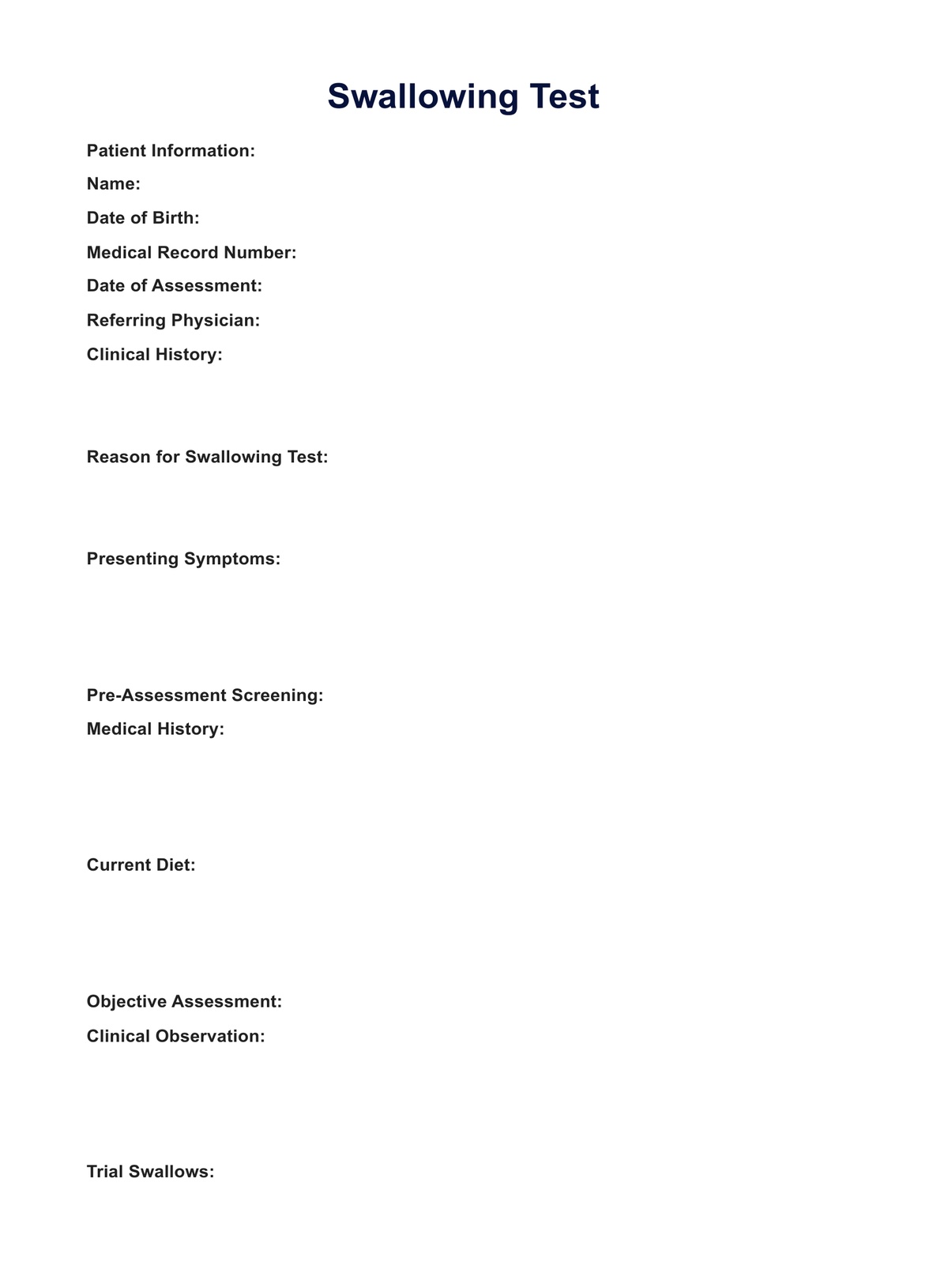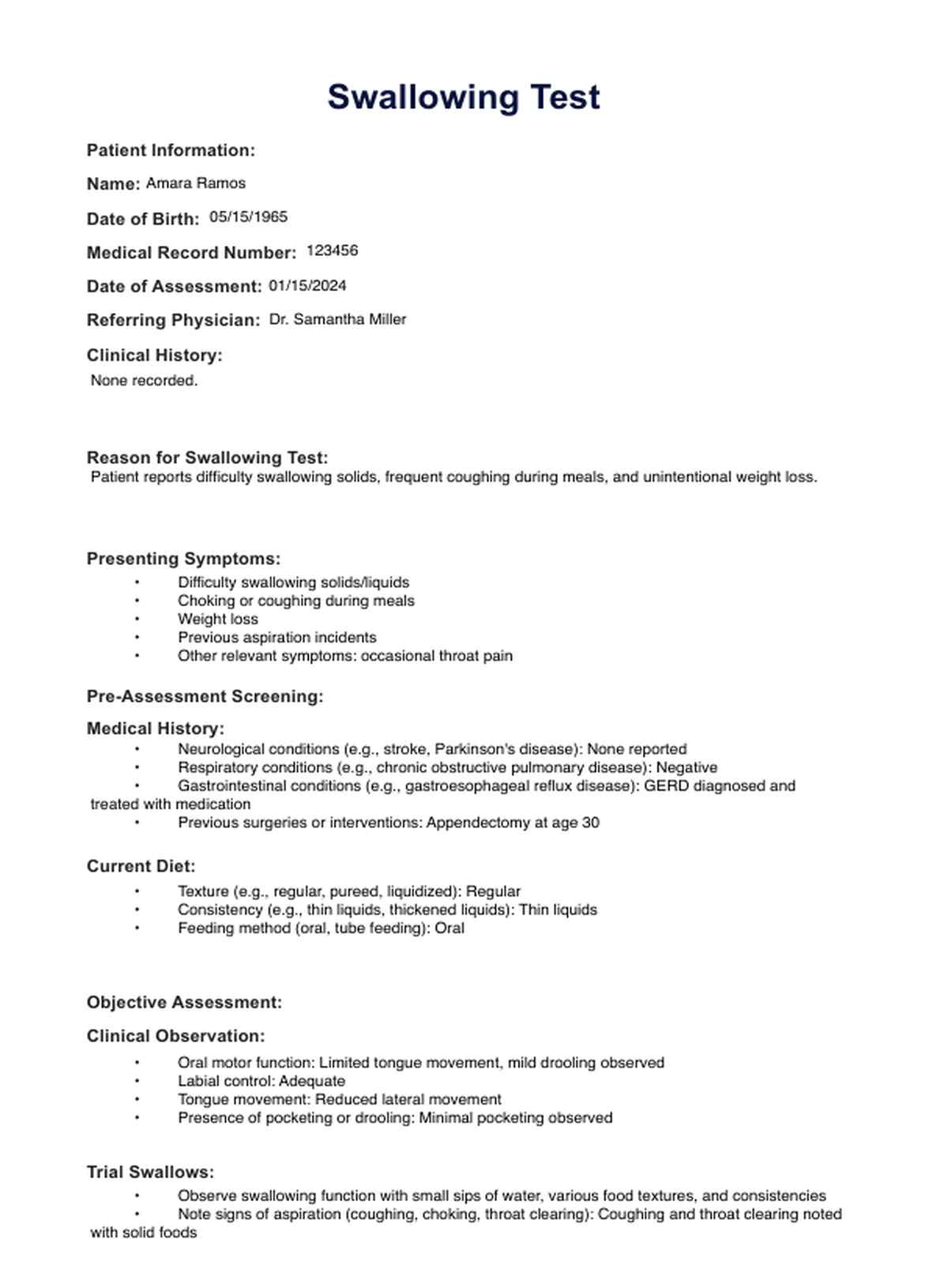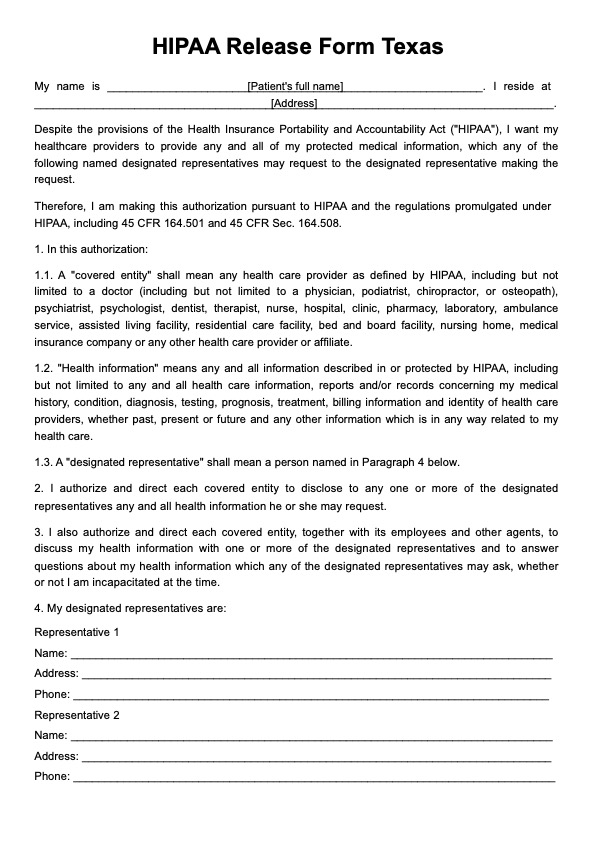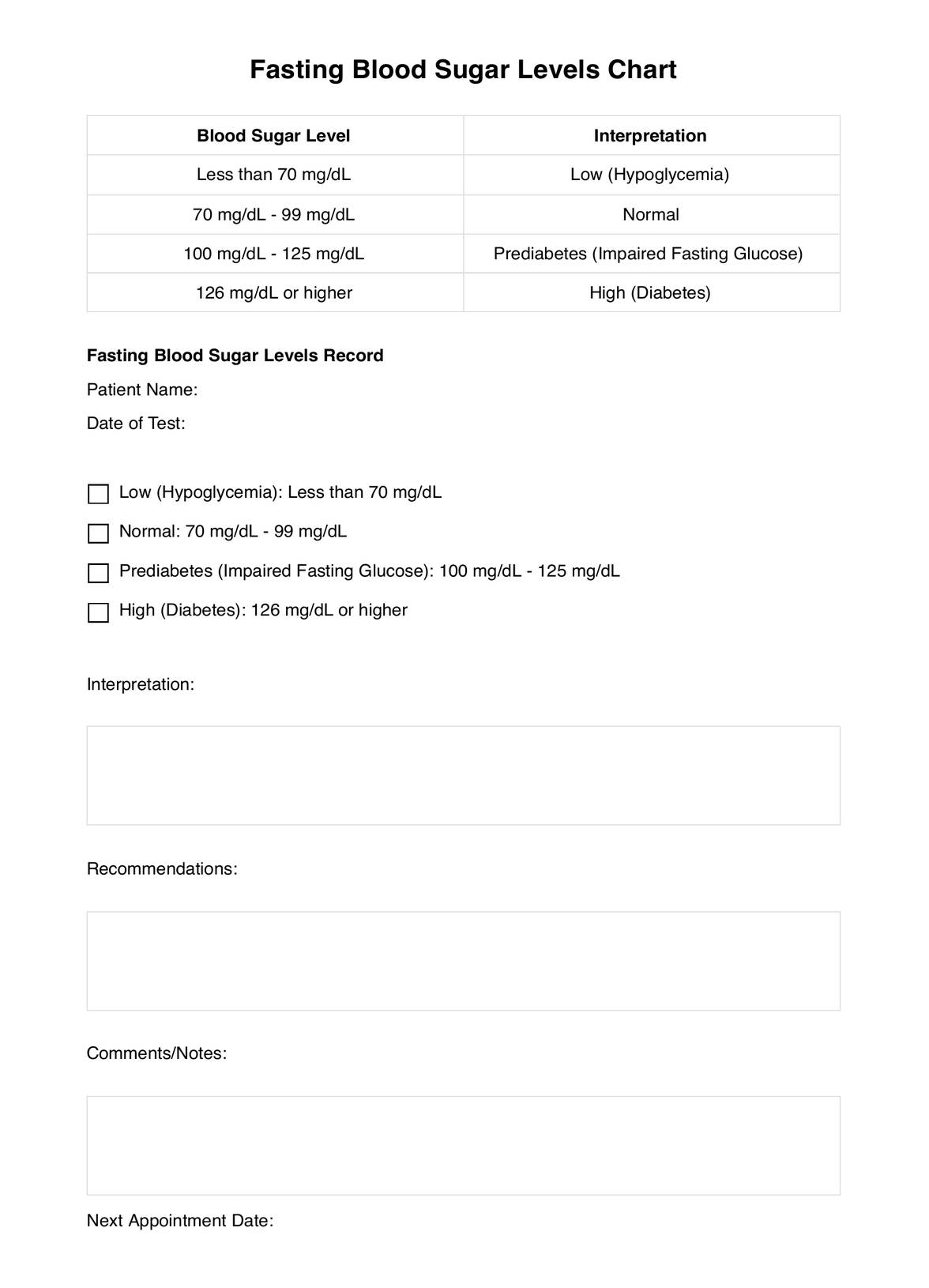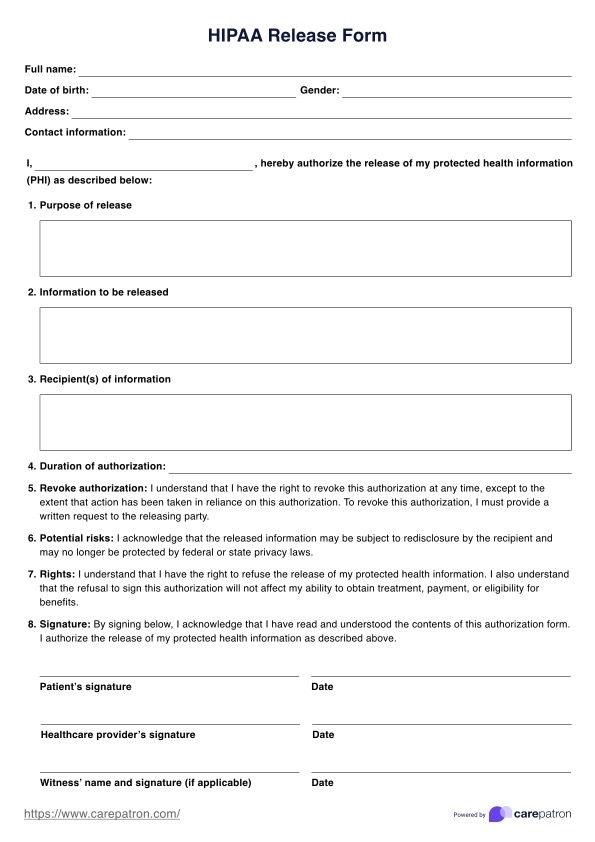Swallowing Test
Learn about the Swallowing Test and its importance in diagnosing swallowing disorders, and get access to a free PDF download.


What is the Swallowing Test?
A swallowing test, or a dysphagia evaluation, is a diagnostic procedure designed to assess an individual's ability to swallow safely and effectively. It is a critical examination used by healthcare professionals, particularly speech-language pathologists, and otolaryngologists, to identify and evaluate any abnormalities or difficulties in the swallowing process.
During a swallowing test, the patient is typically asked to consume various food and liquid consistencies while the healthcare professional observes and assesses the entire swallowing mechanism.
This evaluation goes beyond merely identifying the ability to swallow; it delves into the intricate coordination of muscles involved in the process, examining the oral, pharyngeal, and esophageal phases.
One of the primary purposes of a swallowing test is to diagnose dysphagia, a condition characterized by difficulty swallowing. Dysphagia can result from various medical conditions, including neurological disorders, muscular diseases, or structural abnormalities.
Healthcare providers can tailor treatment plans to address underlying causes and enhance overall swallowing function by pinpointing a patient's specific challenges during swallowing.
The importance of a swallowing test cannot be overstated. Undiagnosed or untreated swallowing difficulties can lead to serious health consequences, such as malnutrition, dehydration, and aspiration pneumonia. Food or liquids enter the airway in this condition, potentially causing respiratory issues.
A timely and accurate swallowing test is crucial for providing appropriate interventions and improving a patient's quality of life.
Swallowing Test Template
Swallowing Test Example
Potential models of swallowing screening
Swallowing screening is a crucial component of healthcare, especially for populations prone to swallowing problems, such as acute stroke patients. Various models of swallowing screening have been developed to efficiently identify and address oropharyngeal dysphagia in specific patient groups.
Some notable models are tailored for acute stroke patients and those experiencing swallowing difficulties.
Mann assessment of swallowing ability (MASA)
The Mann Assessment of Swallowing Ability (MASA) is a widely recognized model for evaluating swallowing function, particularly in stroke patients. Developed to assess oropharyngeal dysphagia, MASA focuses on identifying impairments in the oral and pharyngeal phases of swallowing.
Its structured approach aids healthcare professionals in pinpointing specific challenges faced by acute stroke patients, enabling targeted interventions for improved swallowing safety.
Gugging swallowing screen (GUSS)
Designed explicitly for acute stroke patients, the Gugging Swallowing Screen (GUSS) is a rapid and reliable screening tool. It efficiently identifies individuals at risk of swallowing problems by assessing oral motor function and the presence of dysphagia symptoms.
Burke dysphagia screening test
The Burke Dysphagia Screening Test (BDST) is a quick and easy bedside test used to identify patients who are at risk for dysphagia (swallowing difficulty) and aspiration (inhaling food, liquids, or secretions). It is a simple seven-item test that can be completed by a nurse, physician, or other healthcare professional in 15 minutes or less.
The BDST consists of the following seven items:
- History of dysphagia: The patient is asked if they have ever had any difficulty swallowing.
- Coughing or choking during meals: The patient is asked if they cough or choke when they eat or drink.
- Wet voice: The patient is asked if their voice is wet or gurgly.
- Drooling: The patient is asked if they drool excessively.
- Nasal regurgitation: The patient is asked if food or liquid comes out of their nose when they eat or drink.
- Dysphonia (voice changes): The patient is asked if their voice has changed.
- Coughs after swallowing 3oz water: The patient is given 3oz of water to drink and then observed for coughing or choking.
The simplicity of GUSS makes it a valuable model for quick evaluation, ensuring timely interventions for stroke patients susceptible to oropharyngeal dysphagia.
Toronto bedside swallowing screening test (TOR-BSST)
Tailored for use at the bedside, the Toronto Bedside Swallowing Screening Test (TOR-BSST) is an effective model for screening stroke patients for swallowing difficulties. This screening tool considers both overt and silent signs of dysphagia, providing a comprehensive assessment.
By incorporating TOR-BSST into routine care, healthcare providers can promptly identify and manage swallowing issues in acute stroke patients.
Materials
Swallowing screening relies on a range of materials to effectively assess individuals, especially those at risk, such as stroke patients, for oropharyngeal dysphagia.
These materials are crucial in various screening methods and diagnostic tools, accurately identifying potential issues and facilitating timely intervention to prevent complications like aspiration pneumonia.
Here are key materials commonly utilized in swallowing screening:
Modified barium swallow (MBS)
The Modified Barium Swallow (MBS) is a radiographic examination that uses barium-coated food and liquid consistencies to visualize the swallowing process in real time. Particularly valuable for stroke patients, MBS allows healthcare professionals to assess the oral, pharyngeal, and esophageal phases of swallowing.
This method aids in identifying abnormalities and guiding interventions to prevent complications associated with oropharyngeal dysphagia in acute stroke cases.
Fiberoptic endoscopic evaluation of swallowing (FEES)
Fiberoptic Endoscopic Evaluation of Swallowing (FEES) involves passing a flexible endoscope through the nasal passage to directly observe the pharyngeal and laryngeal areas during swallowing.
This technique is instrumental in evaluating the structural and functional aspects of swallowing, making it a valuable tool for assessing oropharyngeal dysphagia in stroke patients. FEES is handy for identifying aspiration risk and guiding appropriate management strategies.
Swallowing assessment kit
A Swallowing Assessment Kit typically includes various textures and volumes of food and liquid, allowing for a systematic assessment and clinical notes of swallowing function. This kit is essential in screening stroke patients for oropharyngeal dysphagia by simulating real-world eating conditions.
It provides valuable insights into a patient's ability to manage different consistencies, helping healthcare professionals tailor interventions to improve swallowing safety.
Pulse oximetry
In addition to visual assessments, Pulse Oximetry is a non-invasive method to measure oxygen saturation levels during swallowing screening. This is crucial in detecting potential silent aspiration events in stroke patients, where material enters the airway without overt signs.
Monitoring oxygen saturation aids in identifying patients at risk of aspiration pneumonia and guides appropriate management strategies.
Utilizing this pulse oximetry template can elevate your practice and client success. This resource assists clients in developing actionable improvement plans.
Methods
Swallowing screening involves a systematic approach to assess individuals, especially those with acute stroke, for potential swallowing disorders and aspiration risk.
The methods employed in these screenings aim to identify issues related to speed and language of swallowing, enabling healthcare professionals to tailor interventions effectively.
Here are key methods commonly followed in swallowing screening:
Bedside assessment
Conducting a Bedside Assessment is a fundamental step in swallowing screening, particularly for individuals with acute stroke. This method involves observing the patient's oral intake, assessing oral motor function, and identifying overt signs of dysphagia during eating.
Bedside assessments provide valuable initial insights, aiding the decision to proceed with further diagnostic evaluations.
Penetration aspiration scale (PAS)
The Penetration Aspiration Scale (PAS) is a standardized tool to quantify the depth of material entering the airway during swallowing. This method is integral in evaluating the severity of aspiration risk in individuals, including those with acute stroke.
PAS categorizes aspiration events, ranging from material not entering the airway to penetration and aspiration, providing a standardized framework for assessing the impact of swallowing disorders.
Dysphagia screening tool
Dysphagia Screening Tools are designed to quickly and efficiently identify individuals at risk of swallowing difficulties. These tools are handy in acute stroke settings, where timely assessments are crucial.
Utilizing standardized questionnaires and observation, dysphagia screening tools enable healthcare professionals to triage patients and determine the need for more in-depth assessments.
Direct Swallowing Test
Conducting a Direct Swallowing Test involves assessing the patient's ability to swallow with different consistencies of food and liquids. This method is essential for identifying specific challenges related to the speed and language of swallowing.
Direct Swallowing Tests allow healthcare professionals to tailor interventions based on the patient's needs, ensuring targeted and effective management of swallowing disorders.
When to administer the Swallowing Test
Knowing when to administer a swallowing test is crucial for the timely identification and management of aspiration risk and swallowing disorders. The decision to conduct a swallowing test should be based on clinical judgment, patient history, and specific indications. Here's a comprehensive guide on when to consider a swallowing test:
Healthcare professionals typically initiate a swallowing test when a patient presents with symptoms or conditions associated with aspiration risk or swallowing disorders. Common triggers include a history of stroke, respiratory issues, neurological disorders, or recent surgery involving the head and neck.
Interpreting the results: Next steps
After conducting a swallowing test, interpreting the results is crucial in guiding appropriate interventions and patient management. Understanding the implications of various outcomes allows healthcare professionals to tailor their approach to address specific issues identified during the assessment.
Here's a breakdown of common results and their implications:
Normal swallowing function
If the results indicate normal swallowing function, the patient can safely and effectively swallow different consistencies without signs of aspiration or difficulty. In such cases, healthcare providers may focus on maintaining overall oral health and nutrition, with routine monitoring to address any changes in the future.
Oropharyngeal dysphagia
The presence of oropharyngeal dysphagia signifies difficulties in the oral and pharyngeal phases of swallowing. This result may indicate underlying neurological or muscular issues affecting the coordination of swallowing muscles. Treatment options may include modified diets, swallowing exercises, and, in severe cases, implementing feeding tubes to reduce the risk of aspiration.
Aspiration risk
Identifying an aspiration risk suggests that materials, such as food or liquid, enter the airway during swallowing, increasing the likelihood of respiratory complications. In such cases, healthcare providers may recommend dietary modifications, swallowing therapy, or even more advanced interventions, such as surgery or medication, to mitigate the risk of aspiration pneumonia.
Silent aspiration
Silent aspiration occurs when material enters the airway without overt signs, such as coughing or choking. This result may necessitate close monitoring and targeted interventions to prevent respiratory issues. Strategies may include modifying food and liquid textures and implementing swallowing exercises to improve airway protection.
Recommendations for further testing
In some cases, the results may indicate the need for additional testing, such as a fiberoptic endoscopic evaluation of swallowing (FEES) or a modified barium swallow (MBS). These advanced diagnostic tools provide more detailed information about the structural and functional aspects of swallowing, helping to guide more specific and targeted interventions.
Research and evidence
Swallowing, a seemingly effortless act, is a complex feat orchestrated by a symphony of muscles and nerves. Yet, when this delicate dance falters, the consequences can be severe. Enter the swallowing test, a diagnostic tool that peeks into this hidden world, shedding light on potential dysfunctions. But how did this test come to be? And what role does it play in modern medicine?
The earliest clues of swallowing tests date back to the 18th century. Through autopsies, physicians like Giovanni Battista Morgagni observed anatomical abnormalities linked to swallowing difficulties. However, visualizing the swallowing process in real time remained a challenge.
According to the records of the National Institutes of Health (1996), a breakthrough arrived in the late 19th century with the invention of the X-ray by Wilhelm Röntgen. This technology allowed doctors, for the first time, to capture dynamic images of the internal body. In 1897, Austrian physician Rudolf Eisenberger used X-rays to study the esophagus, marking the birth of radiographic swallowing examinations.
Over the following decades, the barium swallow evolved. Fluoroscopy, a real-time X-ray technique, allows doctors to observe swallowing in motion. Videofluoroscopic swallowing studies (VFSS), the gold standard for swallowing assessments today, were developed in the 1960s, incorporating video recording for detailed analysis.
While X-ray-based methods remain dominant, other technologies are emerging. Fiberoptic endoscopic evaluation of swallowing (FEES) uses a thin, flexible camera inserted through the nose to visualize the throat and larynx during swallowing directly. This allows for a more nuanced assessment of upper airway function.
Swallowing tests play a crucial role in diagnosing and managing swallowing disorders, collectively known as dysphagia. According to Panebianco (2020), dysphagia can affect people of all ages, from infants with neurological conditions to older adults with stroke or neurodegenerative diseases.
Research is ongoing to develop even more sophisticated swallowing tests. Innovations like MRI-based VFSS offer better soft tissue visualization without radiation exposure. Artificial intelligence is also being explored to automate swallowing test analysis, improving efficiency and accuracy.
Commonly asked questions
A swallowing test typically involves the patient consuming various food and liquid consistencies while a healthcare professional observes the swallowing process. This assessment may use tools like fiberoptic endoscopic evaluation or modified barium swallow to provide detailed insights into the oral, pharyngeal, and esophageal phases of swallowing.
Failing a swallow test indicates potential difficulties or abnormalities in swallowing function. The following steps may involve further diagnostic tests, consultation with specialists, and implementing targeted interventions, such as modified diets or swallowing therapy, to address the identified issues.
Diagnostic tests for difficulty swallowing may include a modified barium swallow (MBS), fiberoptic endoscopic evaluation of swallowing (FEES), or a clinical swallowing examination. These tests help identify the underlying causes of swallowing difficulties, allowing healthcare professionals to develop tailored treatment plans.


